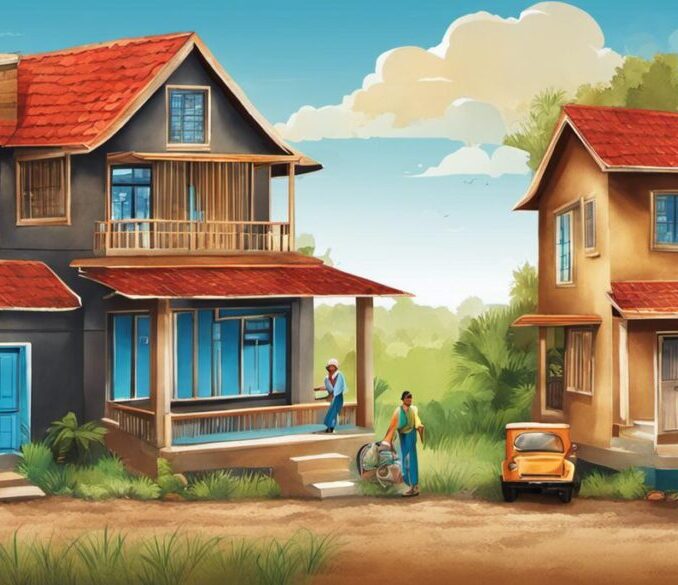
Basic Purpose Micro Finance Home Loans
Micro-finance has emerged as an innovative, impactful financial tool that empowers low-income individuals and families, ultimately advancing their economic self-sufficiency. Among the various micro-finance products available today, micro finance home loans are particularly notable, paving the way for affordable homeownership for many who lack access to traditional lending methods. This piece enlightens on the concept of micro finance home loans, their intrinsic benefits, and the intricate process of qualification. It also delves into potential risks, providing an all-around perspective on this unique financial instrument.
Microfinance Home Loans
Microfinance home loans, also known as micro mortgages, are small, short-term loans extended to low-income households to assist them in purchasing a home. These loans are designed to promote affordable homeownership among the underserved populations, especially individuals who typically have difficulty qualifying for traditional home loans due to lack of credit history, nontraditional employment, or other financial challenges.
Purpose of Microfinance Home Loans
The primary purpose of microfinance home loans is to bridge the gap between low-income individuals and affordable homeownership. Homeownership can provide stability, security, and a sense of pride amongst homeowners, but it often remains out of reach for many due to stringent loan approval requirements. Microfinance institutions (MFIs) aim to make owning a home more accessible by providing small, flexible loans with lower down payments, and simplified approval processes.
Functioning of Microfinance Home Loans
Unlike conventional banks, Microfinance Institutions (MFIs) adopt a more unconventional approach. They assess an applicant’s eligibility for a home loan using different criteria such as repayment capacity, individual’s trade or business stability, rather than just relying on credit scores. The loans are typically small and have higher interest rates than traditional mortgages, to account for the higher risk. However, the terms of these loans are often more flexible, with MFIs often working directly with borrowers to create manageable repayment plans.
Popularity Of Microfinance Home Loans Among Low-Income Households
Microfinance home loans have gained popularity among low-income households for their accessibility and flexibility. These loans provide an opportunity for low-income households to become homeowners, which can be a transformative step towards an improved quality of life and financial stability. They also play a significant role in slum upgrading efforts and providing formal housing opportunities in low-income communities.
Essentiality In Affordable Homeownership
Microfinance home loans play a crucial role in promoting affordable homeownership. In many parts of the world, affordable housing is a critical issue, and these loans provide a solution for families unable to qualify for conventional mortgages. Through these loans, low-income households are able to secure and invest in a residential property, a critical asset, which goes a long way in securing their future, breaking the poverty cycle in the process.
Advantages And Benefits of Micro Finance Home Loans
Microfinance home loans, often referred to as microcredit home loans, aim to provide affordable and accessible mortgage finance options for lower-income individuals and families who may find it challenging to secure traditional home loans. The key facets of their affordability and accessibility include smaller loan amounts, typically lower interest rates, and more flexible repayment structures.
On top of that, microfinance institutions generally eliminate common obstacles associated with securing traditional loans. These institutions often require fewer formalities to apply for a loan and are more lenient with collateral requirements and credit history checks. This flexibility allows applicants to secure funding without the necessity of having a high income or substantial property assets, making home acquisition more within reach for less privileged families.
Risks Of Microfinance Home Loans
When engaging with microfinance home loans, it’s essential to understand that they come with potential hurdles and risks. These loans frequently bear higher interest rates than traditional mortgages due to the heightened risk associated with lending to low-income borrowers. Additionally, misunderstandings about the loan terms or a lack of sufficient knowledge can lead to repayment difficulties, placing additional financial strain on the borrower. It’s critical for borrowers to attain good financial literacy and education, ensuring they fully understand their loan terms and commitments.
Improvement of Creditworthiness
Microfinance home loans can additionally serve to improve the creditworthiness of borrowers. Since the loan amounts are smaller, borrowers are more likely to routinely meet repayment deadlines, which consequently aids in building a solid credit score.
Many microfinance institutions also provide the added advantage of financial education. This can include guidance about managing finances, savings, and repayable debt, which helps borrowers to better understand and maintain their financial health. As a result, when these individuals prove themselves capable of meeting the obligations of their microcredit, it opens the possibility of accessing larger loans in the future–therefore improving their overall creditworthiness.
Homeownership and Breaking Rental Cycles
Microfinance home loans can provide a pathway out of perpetual renting for many families, offering them the opportunity to build assets and gain more financial stability. Homeownership is a key wealth-building tool, and owning a home can provide numerous benefits that renting cannot, such as potential appreciation of property value and tax advantages.
The process of securing a microfinance home loan, making regular repayments, and ultimately owning a home, creates a positive ripple effect. It can help a family to escape the uncertainty of the rental cycle, where regular displacement, unrecoverable rental payments, and ever-increasing rents are typical challenges.
Paradoxically, the regular repayments on a microfinance home loan can be similar to – or even less than – rental payments. With the added potential of property value appreciation, it is easy to see how microfinance home loans can be leveraged as an effective tool to break the rental cycle and establish secure and long-term housing situations.
Microfinance home loans serve as a crucial gateway towards economic inclusion. These affordable home financing options not only improve creditworthiness but also aid individuals and families in their journey from being renters to becoming homeowners
Tips For Applying for Micro Finance Home Loans
The application process for a microfinance home loan is similar to that of a traditional home loan, though it is typically more streamlined and less stringent in terms of credit requirements.
How to Apply for a Microfinance Home Loan
To apply, you would need to approach a microfinance institution (MFI) and fill out an application form. This is usually followed by a background check and assessment of your financial status to determine your ability to repay the loan.
Necessary Documentation for Microfinance Home Loans
Even though microfinance home loans are designed for people with limited financial resources, you should still be prepared to provide some documentation. This typically includes proof of income, employment status, and sometimes proof of residence or citizenship. Depending on the MFI, you may also have to provide bank statements, information about outstanding debts, and possibly references.
Increasing Chances of Loan Approval
To increase your chances of a microfinance home loan approval, there are several strategies you can employ. First, ensure that all documentation is accurate, valid, and properly organized. Secondly, maintain a steady source of income – this could be from selling goods, offering services, or regular employment. The idea is to show the MFI that you are capable of making consistent payments.
Furthermore, you could consider participating in a financial literacy or credit counselling course. Some MFIs count this as a positive factor when considering your loan application as it demonstrates your dedication and preparedness to handle a loan.
Last but not least, have a clear plan for the funds. Whether it be for repair, purchase, or construction, the ability to convincingly articulate how the loan will be used can provide assurance to the lender that the funds won’t be misused.
Special Considerations
If your initial application is denied, don’t be disheartened. It’s worthwhile asking for feedback, as this can help you identify weak areas that need to be strengthened before you apply again. If lack of credit history is a roadblock, consider starting with a smaller loan and making regular, timely repayments to build your credit.
Remember, each MFI has its own set of criteria and considerations, so research well to find the one best suited to your situation. Patience, persistence, and preparation are key to securing a microfinance home loan.





Be the first to comment